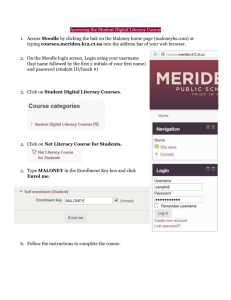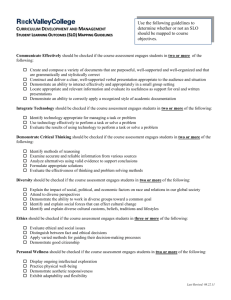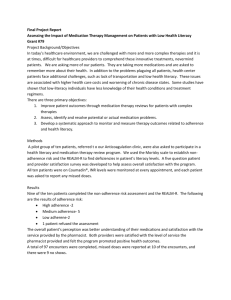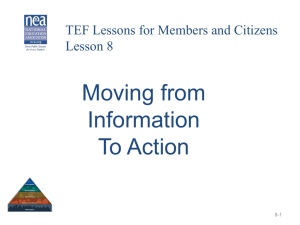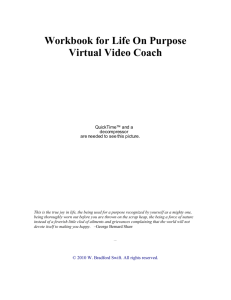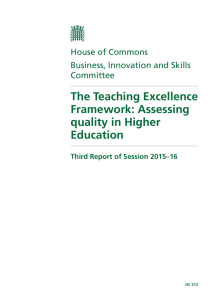Literacy Coach Matrix - Pasco County Schools
advertisement
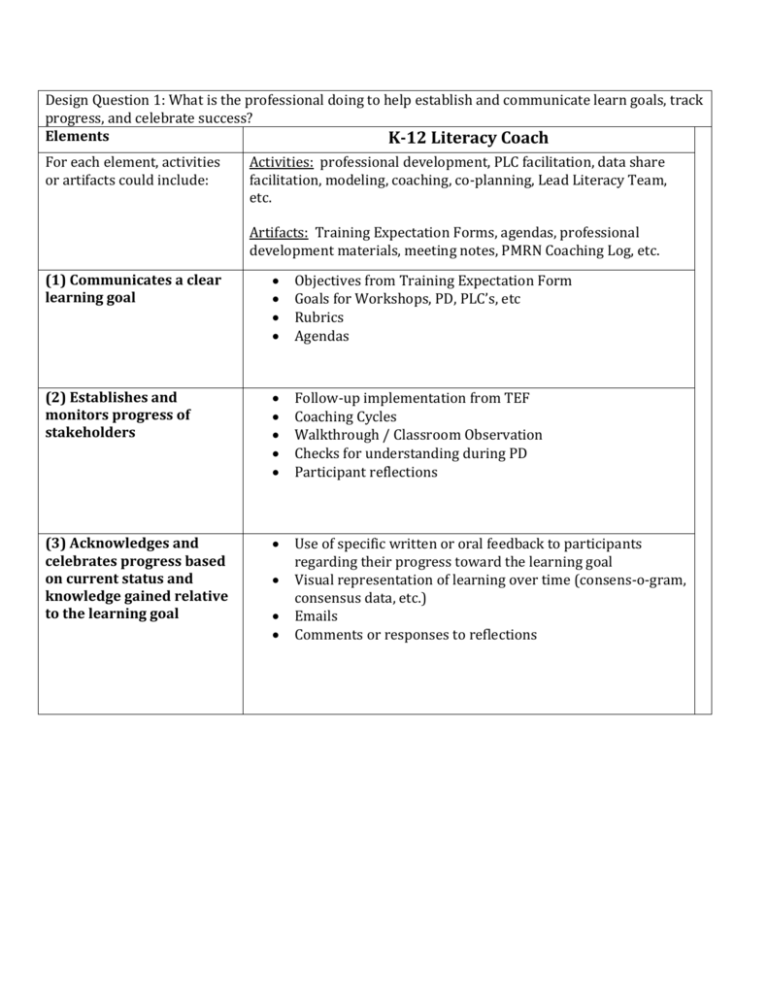
Design Question 1: What is the professional doing to help establish and communicate learn goals, track progress, and celebrate success? Elements K-12 Literacy Coach For each element, activities or artifacts could include: Activities: professional development, PLC facilitation, data share facilitation, modeling, coaching, co-planning, Lead Literacy Team, etc. Artifacts: Training Expectation Forms, agendas, professional development materials, meeting notes, PMRN Coaching Log, etc. (1) Communicates a clear learning goal Objectives from Training Expectation Form Goals for Workshops, PD, PLC’s, etc Rubrics Agendas (2) Establishes and monitors progress of stakeholders Follow-up implementation from TEF Coaching Cycles Walkthrough / Classroom Observation Checks for understanding during PD Participant reflections (3) Acknowledges and celebrates progress based on current status and knowledge gained relative to the learning goal Use of specific written or oral feedback to participants regarding their progress toward the learning goal Visual representation of learning over time (consens-o-gram, consensus data, etc.) Emails Comments or responses to reflections Design Question 2: What is the professional doing to help stakeholders effectively interact with new knowledge? Elements (6) Begins session by explaining why information is important Posting connections to TEF objectives, SIP goals, data, etc. Agenda Email prior to session Learning goals posted on slide (7) Organizes stakeholders to allow for processing of new information Purposeful grouping during PD Use of collaborative structures (8) Provides activities to link new content Pre-reading used to preview new content Graphic organizers or directed note taking (9) Breaks the information into small chunks PD Plan / Module organizer Agendas (10) Engages stakeholders in summarizing activities Tickets out the door Self-reflections Design Question 3: What is the professional doing to help stakeholders practice and deepen their understanding of new knowledge? Elements (11) Uses specific strategies Academic game to review important Follow-up communication information Agenda / Plan (12) Groups stakeholders to facilitate practice and deepening of knowledge Purposeful grouping during PD Use of collaborative structures (13) Engages stakeholders in identifying and addressing barriers to progress and/or misconceptions Includes Problem Solving Process Action Plan (14) Engages stakeholders in examination of content Design Question 4: What is the professional doing to help stakeholders generate and test hypotheses about new knowledge? Elements (15 a) Interacts with Needs assessment stakeholders to determine Survey needs Data review (15 b) Facilitates an activator so that the stakeholder’s identify the importance of generating/testing a hypothesis or “why” statement (15 c) Indicates data-based decision making involving the problem solving process (16) Provides time, access, resources and guidance to stakeholders Organizes and shares relevant data Facilitate problem solving sessions (grade level, class or individual students) Agenda Action plan Maintains a schedule to meet and work with stakeholders Locates and shares resources to support instruction Facilitate and Support collaborative planning Email Online resource support (Moodle, Edmodo, etc.) Design Question 5: What is the professional doing to engage stakeholders? Elements (17 a) Uses appropriate activities/learning aids and pacing techniques to engage stakeholders (17 b) Monitors and adjusts to energy levels of stakeholders (18) Uses response rate techniques to maintain engagement Response cards Plan illustrating technology integration (19 a) Uses cues (tone of voice, body position, level of excitement (19 b) Adjusts energy level and makes personal connections to the content (20) Elicits and accepts varying perspectives and opinions on content, when appropriate Design Question 6: What is the professional doing to establish or maintain procedures? Elements (4) Involves others when developing and maintaining routines Collaboration with Lead Literacy Team or School Based Leadership Team Evidence of use of school/team norms, and/or core values (5) Organizing the Physical Layout of the Classroom Materials are prepared and ready for use Seating fosters collaboration Design Question 7: What is the professional doing to recognize and acknowledge adherence or lack of adherence to rules and procedures? Elements (21 a) Makes eye contact with all stakeholders and physically occupies all quadrants of the environment (21 b) Recognizes potential sources of disruption and deals with them immediately Purposeful seating plan (22) Provides fair and appropriate verbal, nonverbal and/or written feedback when rules and/or procedures are not followed (23) Consistently and fairly acknowledges adherence to rules and procedures Email Design Question 8: What is the professional doing to establish and maintain effective relationships with stakeholders? Elements (24 a) Engages in Email discussions with stakeholders about events/interest in their lives (24 b) Builds on stakeholders interests and demonstrates an understanding of their backgrounds (25 a) Compliments stakeholders regarding personal and academic accomplishments (25 b) Uses humor, smiles, and proximity when appropriate (26 a) Interacts with stakeholders in a calm controlled fashion (26 b) Does not exhibit extremes in positive or negative emotions (26 c) Communicates effectively with stakeholders Email Certificates of recognition Email Newsletters Podcasts Moodle Design Question 9: What is the professional doing to communicate high expectations for all stakeholders? Elements (27 a) Provides nonverbal indicators, indicating value and respect (27 b) Provides verbal indicators of value and respect (28 a) Breaks information/questions into smaller parts and adapts content/context to meet the needs of all stakeholders, as needed (28 b) Corrects misunderstood information in a constructive and supportive manner (28 c) Checks for understanding (28 d) Clarifies information, as needed Learning plan for the year or module Email Newsletter Reflection questions Tickets out the door Survey Email
